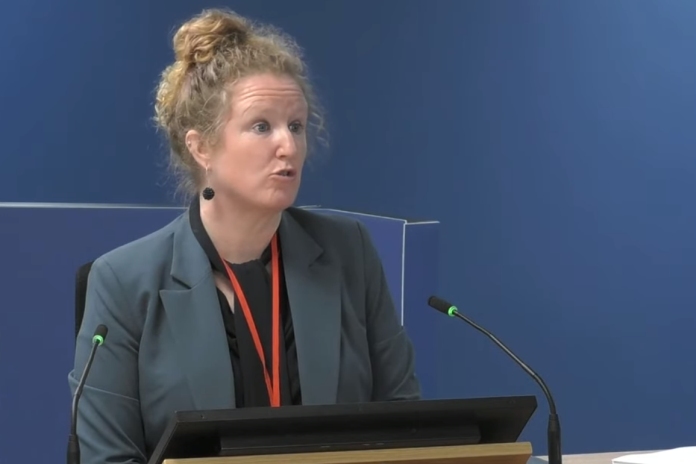
The fire safety manual for Grenfell Tower was not complete, while the health and safety file compiled for the building during refurbishment works was “not easily understandable”, the Grenfell Tower Inquiry has head.
Expert witness Dr Barbara Lane, a director of Arup who was giving evidence to the Inquiry for a second day, was questioned by counsel to the Inquiry Rose Grogan about fire safety details passed on about the building under regulation 38 of the Building Regulations, as well as the health and safety file produced as required under the Construction (Design and Management) Regulations.
Fire safety manual
The Inquiry heard how both sets of information were “merged together” in one building manual for Grenfell Tower. Lane said: “It is really confusing…at Grenfell Tower, there was one building manual with several parts, one part of which was the health and safety file. The rest of the parts were not the health and safety file. It takes months and months and months to work all of that out for Grenfell.”
Lane explained that she regarded the fire safety manual as a “concept” that didn’t have to be an entity in itself.
“The important part of regulation 38 is that the fire safety information the responsible person needs to do all sorts of different things…is available for that responsible person," she said. "When they take possession of the building , they have to set up a fire risk assessment process, they have to set up a maintenance programme, they have to write an emergency plan, they need to brief the Fire Brigade on what measures are being provided to them, so they need information…
"Once you explain where the fire safety information is, in my mind you are delivering a fire safety manual.”
The Inquiry heard how principal contractor Rydon subcontracted out the preparation of the O&M manual to a company called All Group Holdings.
Lane said that such a move was common and “absolutely fine in my mind”, however All Group Holdings only received an instruction to proceed on 11 March 2016, four weeks before scheduled completion of the works, which Lane said was a “very short period of time” to compile a building manual for a project such as Grenfell.
The manual did not contain a self-contained package of information regarding regulation 38 and there was no index indicating where the fire safety information was.
Lane confirmed to Grogan that she had carried out a detailed analysis of the manual in a report she had produced for the Inquiry to see if, despite the lack of an index, the manual itself did in fact contain the relevant fire safety information.
In her conclusions, Lane found that the manual did not contain an as-built fire safety strategy and did not include fire consultant Exova’s outline fire safety strategy, despite the fact this had already been issued to the Kensington and Chelsea Tenant Management Organisation (TMO).
Lane told the hearing that a fire strategy “that reflected the as-built condition needed to be in the building manual, and it was not”. Even if Exova’s outline fire strategy had been included, Lane confirmed that it would not have been adequate to satisfy the requirements of regulation 38 or the guidance in BS 9999 (a code of practice for fire safety in the design, management and use of buildings).
Lane’s report also found that information about active and passive fire protection measures was spread across five different parts of the manual, containing 2,000 documents. She also found that three sections of the building manual that were blank and contained no information.
Asked if it would it be fair to say that that the building manual was not complete with regards to fire safety information, Lane replied: “Yes.”
She also agreed that to the extent that information was present, it was difficult to locate within the manual and that even where there was some information, it was often inadequate to enable the responsible person to discharge their duties.
Nonetheless, Lane also agreed that the standard of the manual was “not unusual” compared with her own professional experience. “I think it’s as bad as the bad manuals I have reviewed in my life,” she said.
Health and safety file
The Inquiry heard how no health and safety file was produced for the primary refurbishment of Grenfell Tower, including the replacement of fire doors, which began in 2011.
Over the course of the refurbishment, the CDM regulations 2007 were superseded by the CDM regulations 2015. Prior to the introduction of the new regulations, employer’s agent Artelia acted as the CDM co-ordinator, however after that role ceased to exist in 2015, the TMO took on the role of principal designer.
In her report, Lane highlighted the fact that as soon as it was appointed, the CDM co-ordinator should have made a start on compiling a health and safety file. Asked if there was evidence of Artelia taking steps to compile the file at the outset of its appointment, Lane replied: “Not that I could find in the evidence.” Asked if there was there a file in place at the time the regulations changed in 2015, she replied: “Not that I could find in the evidence.”
Lane confirmed that she regarded the TMO as being responsible for the lack of a health and safety file. Lane’s report found that the TMO, as the client, was the “common duty holder” and presided over matters but “consistently failed to create or enable a process that complied with the CDM Regulations”.
Explaining what she meant by the fact that the TMO “presided” over matters, she explained: “Because the KCTMO are the client. The client is a duty holder [under the CDM Regulations], but it’s a very specific type of duty holder. They make the appointments, they set up the other duty holders…they have to have information available to them, they have to track what’s happening, so they have a distinct role, and for the KCTMO, any project, not just the primary refurbishment, that fell under those regulations.
"There may have been different CDM co-ordinators over the nine years, so CDM co-ordinators come and go, the client is the client and has been the client, and that’s what I mean when I chose the word ‘presided’."
Prior to the completion of the refurbishment, the TMO asked Rydon to collate the health and safety file and Rydon then subcontracted that work out to All Group Holdings.
Grogan asked: “Is it your understanding that, whilst Rydon agreed to carry out this work and to engage an external company to collate that information, the statutory duty to produce the file at that stage, so after the expiry of the transitional period [between the CDM Regulations 2007 and 2015], rested with the TMO because they were principal designer?”
Lane replied: “They made themselves principal designer and, by doing that, they gave themselves that duty.”
When it came to the health and safety file itself, Grogan detailed how it was three pages long and made up of a series of cross-references back to the building manual.
Lane reviewed the cross-references and found the majority of them pointed to sections that did not exist or linked to incorrect sections of the building manual.
Grogan noted that guidance from the Health and Safety Executive says that information must be in “a convenient form, clear, concise and easily understandable.”
But Lane said in her report: “Based on the inaccuracy of the referencing alone, and also the scale of documentation provided where the referencing is correct, in my opinion this health and safety file, is not in a convenient form, nor clear or concise, nor easily understandable.”
Grogan asked: “You give your overall conclusion that the health and safety file was substantially non-compliant. Does that remain your view?”
Lane replied: “Yes.”
Golden thread
For her final question, Grogan asked Lane why she thought it was important for failures relating to the health and safety file and compliance with regulation 38 in terms of fire safety information to be investigated by the Inquiry.
Lane said: “It’s a circle of compliance. You have got your CDM Regulations, you have got regulation 38, then you have got the Regulatory Reform Order, and what it’s trying to do is transfer relevant fire safety information around that circle to protect people, and there’s two types of people: the people who live or work in a building and the fire brigade.
"I hate the phrase ‘golden thread’, but that’s exactly what it’s about: that it’s simple, easy to find and clear, a narrative about what’s in the building to help people during an emergency. That’s what it’s all about. And that’s why I insisted I write another very long report on the health and safety file, because it’s another place where the law asks of us to provide useful information in the event of a fire. That’s all I was trying to do. Hopefully somebody will listen.”
The Inquiry continues.









